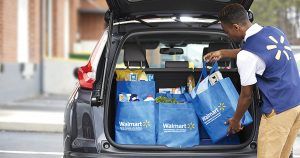The Supply Side: Walmart exec shares insights from online grocery business
by November 23, 2019 11:06 am 1,844 views

Walmart’s investment in online grocery has been significant.
The retail giant has not disclosed the exact dollar investment, but it is believed to be in the billions given the scale of the operation now in nearly 3,000 U.S. stores.
Tom Ward, senior vice president of central operations at Walmart U.S., recently spoke about lessons learned from the grocery service, which has helped the retailer’s overall online sales growth.
“Our online grocery customers are two times as valuable as those who either shop in stores or online, and this service has some of the highest Net Promoter Scores in the industry,” Ward said during a recent speech at the Northwest Arkansas Technology Summit in Rogers.
“We have noticed that our customers pop in and out of online shopping. They sometimes want to come to stores and shop, but other times the pickup option works better for their busy schedules. Consumers want choices, and that’s what we are giving them.”
Ward said the secret sauce of the program’s success is the personal shoppers who do the order picking. These employees are the “cream of the crop,” and they have the closest contact with customers, he added.
“If you train these personal shoppers, they are valuable assets to your business,” Ward said. “We will soon hire our 50,000th personal shopper, which is a huge milestone given the job didn’t exist three years ago.”
By scale, there is no one in Walmart’s league for online grocery. Two years ago, Walmart had roughly 500 stores equipped for online pickup, but since that time the retail giant has added 100 new stores per week. Adding the service to stores requires permits for additional store space/remodels and parking lot adjustments, additional staging areas for the pickup with increased refrigeration, along with training for personal shoppers. On the back-end, the app has to be regularly updated, as are the algorithms that create picking routes for the shoppers.
The app interface between shoppers and the site also has to be user-friendly. There are time-saving features like automatic reorders and appropriate inventory changes for seasonal and other general merchandise shoppers may want to add to their grocery order.
Ward said 18% of the baskets contain fresh items, which means personal shoppers are becoming more trusted at picking fresh products among shoppers. Additionally, he said 98.5% of shoppers buy bathroom tissue.

Walmart has been able to scale its online grocery service in part because of the training it provides personal shoppers who pick eight orders at a time. Part of the training involves smart substitution when the store is out of a product. Because Walmart has a record of each customer’s orders, the technology allows the picker to see what shoppers purchased in the past, and the app makes suggested changes.
Walmart works hard with its suppliers to ensure products are in stock, but there are times when demand outstrips supply. He said the substitution logic built into the system allows thousands of stores to pick an average of 680 orders per day.
“We know what you buy and what you don’t buy, and we have over time been able to determine a proper substitution for fresh blueberries. It is not frozen or canned blueberries. What we have found is that consumers buying fresh blueberries would rather have fresh strawberries if the blueberries are out of stock,” Ward said.
Getting the order filled correctly is important, but Ward said the ease of pickup also needs to be as easy as possible. Once the order is placed online, the customer chooses a pickup time. He said there are a limited number of time slots each hour, and to ensure customers are not waiting during the busiest pickup times, there are prompts on the app to nudge them to choose a “less busy” time.
Ward said this has helped prevent log jams in the staging and loading areas in busy stores. He said updates to the grocery shopping app allow customers to notify Walmart when they are on their way to pick up the order.
“About 75% of customers tell us they are on their way when they cross the geofence at the store, then … we know they have arrived,” Ward said. “They pull into a numbered parking stall and report that number and share the color of their car and press continue. Shoppers will then likely see their order being rolled toward them by the personal shopper. They sign off [on] any substitutions, and the groceries are loaded on their behalf.”
The average pickup time is less than 5 minutes from the minute they pull into the parking lot. Ward said Walmart continues to refine the experience to save customers time.
Another recent feature allows shoppers to add forgotten items to the list. Ward said the “Got It-Forgot It” feature can be accessed when the shopper reopens the grocery app within 60 minutes after the order was placed and add more items to the order. Ward said the average add is 3.2 new items to the basket.
He said the feature is helping to grow total basket size, and consumers have responded favorably.
Editor’s note: The Supply Side section of Talk Business & Politics focuses on the companies, organizations, issues and individuals engaged in providing products and services to retailers. The Supply Side is managed by Talk Business & Politics and sponsored by Propak Logistics.
